An Evaluation of Stimulants' Effects on Academic Performance
VerifiedAdded on 2020/05/01
|11
|2726
|67
Essay
AI Summary
This essay critically evaluates two research articles to determine the impact of stimulants on academic performance among university students. The essay begins with an introduction to the topic, discussing the use of stimulants, particularly among students with learning disabilities or ADHD, and the ...
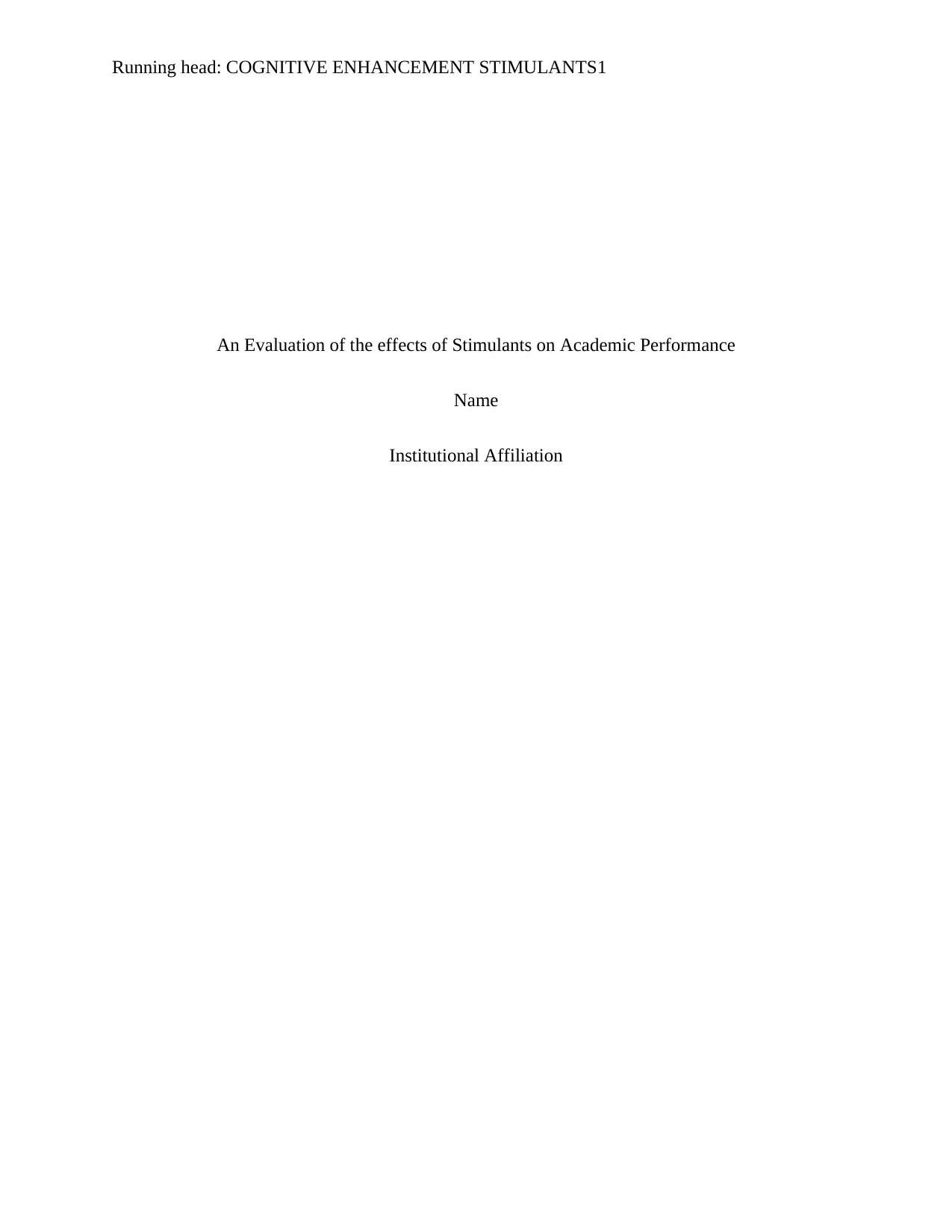
Running head: COGNITIVE ENHANCEMENT STIMULANTS1
An Evaluation of the effects of Stimulants on Academic Performance
Name
Institutional Affiliation
An Evaluation of the effects of Stimulants on Academic Performance
Name
Institutional Affiliation
Paraphrase This Document
Need a fresh take? Get an instant paraphrase of this document with our AI Paraphraser
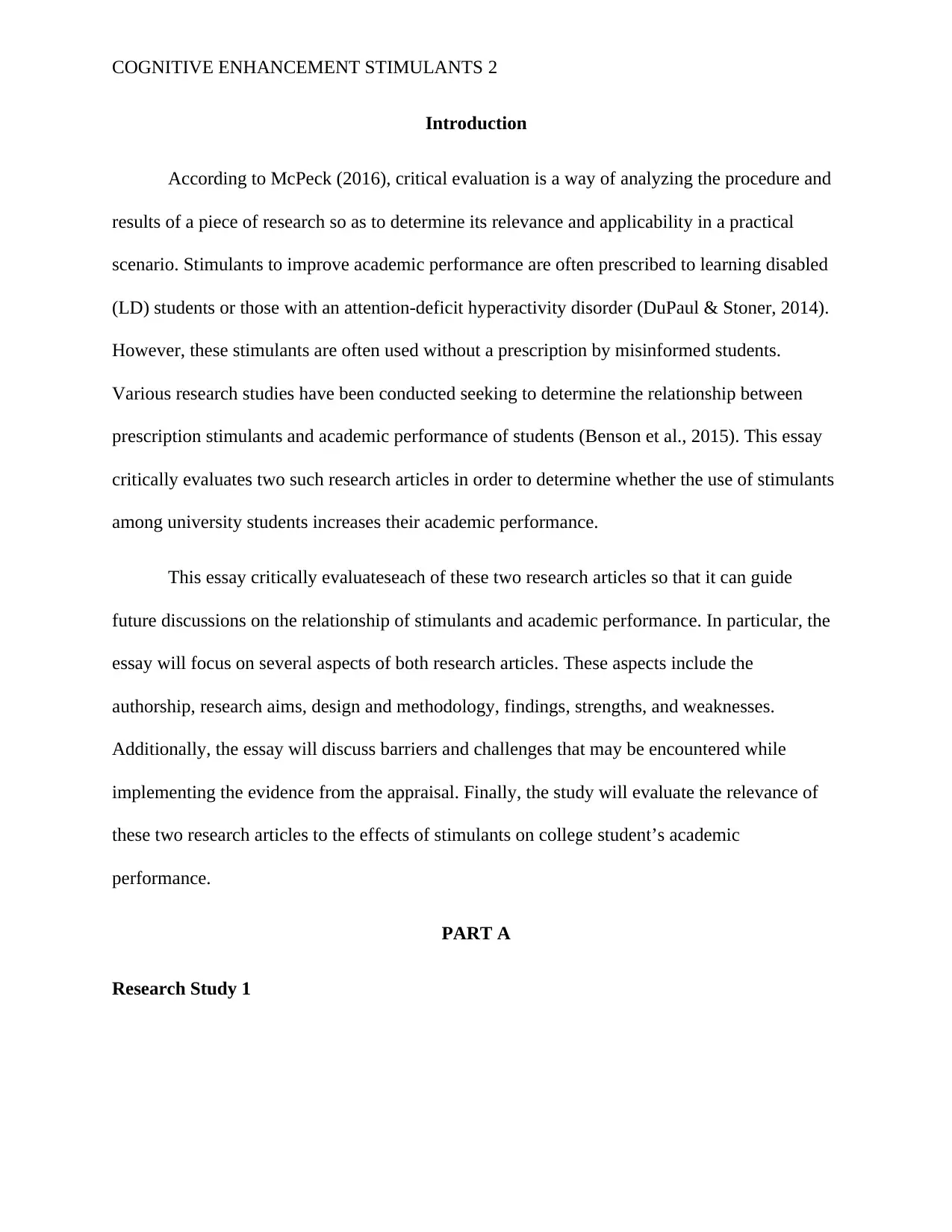
COGNITIVE ENHANCEMENT STIMULANTS 2
Introduction
According to McPeck (2016), critical evaluation is a way of analyzing the procedure and
results of a piece of research so as to determine its relevance and applicability in a practical
scenario. Stimulants to improve academic performance are often prescribed to learning disabled
(LD) students or those with an attention-deficit hyperactivity disorder (DuPaul & Stoner, 2014).
However, these stimulants are often used without a prescription by misinformed students.
Various research studies have been conducted seeking to determine the relationship between
prescription stimulants and academic performance of students (Benson et al., 2015). This essay
critically evaluates two such research articles in order to determine whether the use of stimulants
among university students increases their academic performance.
This essay critically evaluateseach of these two research articles so that it can guide
future discussions on the relationship of stimulants and academic performance. In particular, the
essay will focus on several aspects of both research articles. These aspects include the
authorship, research aims, design and methodology, findings, strengths, and weaknesses.
Additionally, the essay will discuss barriers and challenges that may be encountered while
implementing the evidence from the appraisal. Finally, the study will evaluate the relevance of
these two research articles to the effects of stimulants on college student’s academic
performance.
PART A
Research Study 1
Introduction
According to McPeck (2016), critical evaluation is a way of analyzing the procedure and
results of a piece of research so as to determine its relevance and applicability in a practical
scenario. Stimulants to improve academic performance are often prescribed to learning disabled
(LD) students or those with an attention-deficit hyperactivity disorder (DuPaul & Stoner, 2014).
However, these stimulants are often used without a prescription by misinformed students.
Various research studies have been conducted seeking to determine the relationship between
prescription stimulants and academic performance of students (Benson et al., 2015). This essay
critically evaluates two such research articles in order to determine whether the use of stimulants
among university students increases their academic performance.
This essay critically evaluateseach of these two research articles so that it can guide
future discussions on the relationship of stimulants and academic performance. In particular, the
essay will focus on several aspects of both research articles. These aspects include the
authorship, research aims, design and methodology, findings, strengths, and weaknesses.
Additionally, the essay will discuss barriers and challenges that may be encountered while
implementing the evidence from the appraisal. Finally, the study will evaluate the relevance of
these two research articles to the effects of stimulants on college student’s academic
performance.
PART A
Research Study 1

COGNITIVE ENHANCEMENT STIMULANTS 3
Hildt, E., Lieb, K., & Franke, A. G. (2014). Life context of pharmacological academic
performance enhancement among university students - a qualitative approach. BMC
Medical Ethics, 15(1), 23-23. doi:10.1186/1472-6939-15-23
Authorship
The authors of this article have extensive knowledge and experience in the field of
psychotherapy. Frankie and Lieb are experts in the field of psychiatry and psychotherapy while
Hildt is a neuroethics expert.Authors of this research article have affiliationswith both
thePsychotherapy and Psychiatry departments at theJohannes Gutenberg University’smedical
centre, and the Philosophy department at thesame university. In this research article, the authors
confirmed that there does not exist any conflicts of interest regarding their views and position on
the finding of the research project. All authors of the article participated in the interpretation,
drafting, and revision of the manuscript.
Research aims
The examination of research questions and objectives provide a useful insight into the
relevance of a project (Royce, Thyer & Padgett, 2015).This research article aimed to find out
more about the effects experienced by users of the stimulants, reasons for using the stimulants,
and their impact on academic performance. The research aimed to answer questions on the
reasons behind the use of stimulant among students, the effects of these stimulants on the
students, whether they provide any academic advantages, their impact on the lives of students,
and the possible side-effects that users may experience.According to the author of the article,
most studies on the use of mental enhancements among students predominantly focussed on the
Hildt, E., Lieb, K., & Franke, A. G. (2014). Life context of pharmacological academic
performance enhancement among university students - a qualitative approach. BMC
Medical Ethics, 15(1), 23-23. doi:10.1186/1472-6939-15-23
Authorship
The authors of this article have extensive knowledge and experience in the field of
psychotherapy. Frankie and Lieb are experts in the field of psychiatry and psychotherapy while
Hildt is a neuroethics expert.Authors of this research article have affiliationswith both
thePsychotherapy and Psychiatry departments at theJohannes Gutenberg University’smedical
centre, and the Philosophy department at thesame university. In this research article, the authors
confirmed that there does not exist any conflicts of interest regarding their views and position on
the finding of the research project. All authors of the article participated in the interpretation,
drafting, and revision of the manuscript.
Research aims
The examination of research questions and objectives provide a useful insight into the
relevance of a project (Royce, Thyer & Padgett, 2015).This research article aimed to find out
more about the effects experienced by users of the stimulants, reasons for using the stimulants,
and their impact on academic performance. The research aimed to answer questions on the
reasons behind the use of stimulant among students, the effects of these stimulants on the
students, whether they provide any academic advantages, their impact on the lives of students,
and the possible side-effects that users may experience.According to the author of the article,
most studies on the use of mental enhancements among students predominantly focussed on the
⊘ This is a preview!⊘
Do you want full access?
Subscribe today to unlock all pages.

Trusted by 1+ million students worldwide
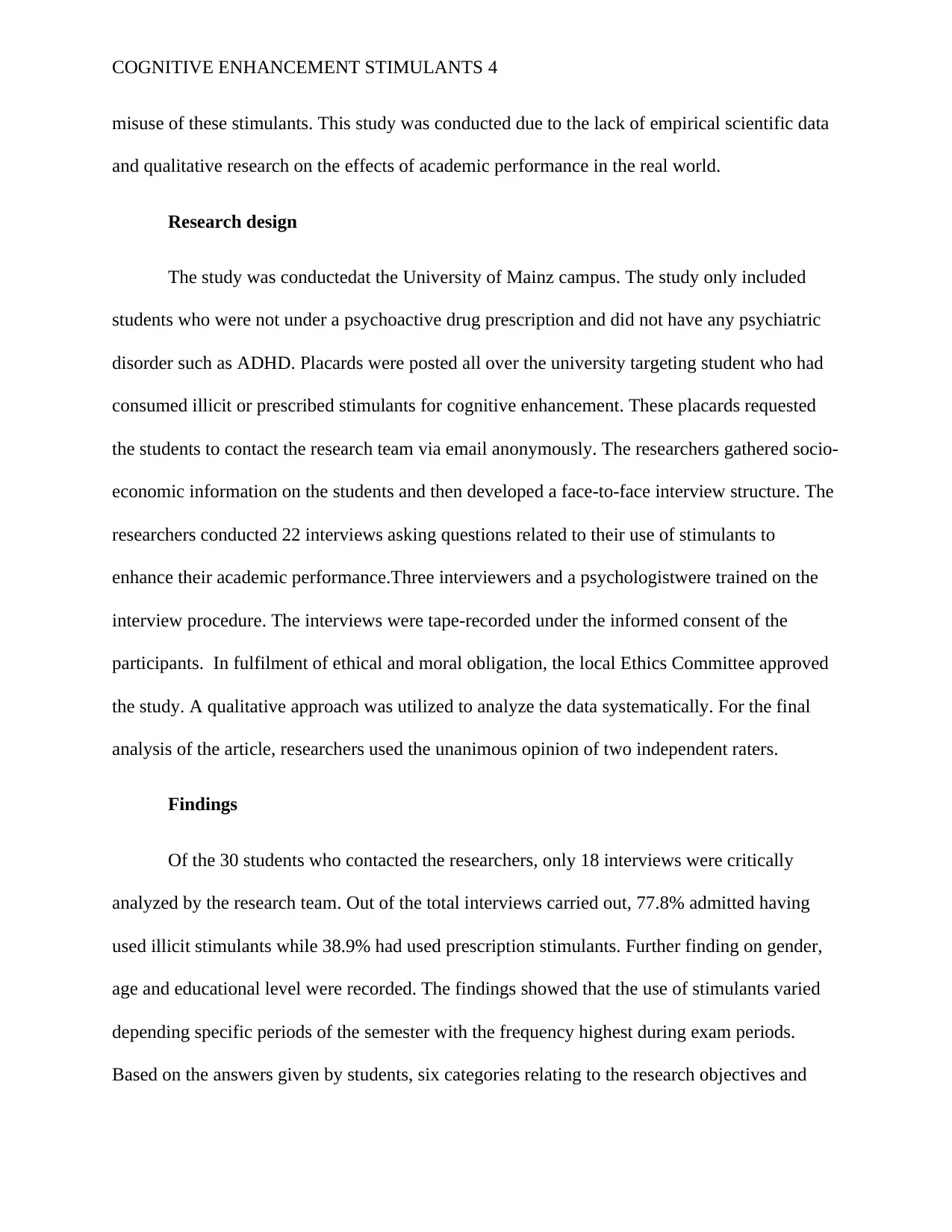
COGNITIVE ENHANCEMENT STIMULANTS 4
misuse of these stimulants. This study was conducted due to the lack of empirical scientific data
and qualitative research on the effects of academic performance in the real world.
Research design
The study was conductedat the University of Mainz campus. The study only included
students who were not under a psychoactive drug prescription and did not have any psychiatric
disorder such as ADHD. Placards were posted all over the university targeting student who had
consumed illicit or prescribed stimulants for cognitive enhancement. These placards requested
the students to contact the research team via email anonymously. The researchers gathered socio-
economic information on the students and then developed a face-to-face interview structure. The
researchers conducted 22 interviews asking questions related to their use of stimulants to
enhance their academic performance.Three interviewers and a psychologistwere trained on the
interview procedure. The interviews were tape-recorded under the informed consent of the
participants. In fulfilment of ethical and moral obligation, the local Ethics Committee approved
the study. A qualitative approach was utilized to analyze the data systematically. For the final
analysis of the article, researchers used the unanimous opinion of two independent raters.
Findings
Of the 30 students who contacted the researchers, only 18 interviews were critically
analyzed by the research team. Out of the total interviews carried out, 77.8% admitted having
used illicit stimulants while 38.9% had used prescription stimulants. Further finding on gender,
age and educational level were recorded. The findings showed that the use of stimulants varied
depending specific periods of the semester with the frequency highest during exam periods.
Based on the answers given by students, six categories relating to the research objectives and
misuse of these stimulants. This study was conducted due to the lack of empirical scientific data
and qualitative research on the effects of academic performance in the real world.
Research design
The study was conductedat the University of Mainz campus. The study only included
students who were not under a psychoactive drug prescription and did not have any psychiatric
disorder such as ADHD. Placards were posted all over the university targeting student who had
consumed illicit or prescribed stimulants for cognitive enhancement. These placards requested
the students to contact the research team via email anonymously. The researchers gathered socio-
economic information on the students and then developed a face-to-face interview structure. The
researchers conducted 22 interviews asking questions related to their use of stimulants to
enhance their academic performance.Three interviewers and a psychologistwere trained on the
interview procedure. The interviews were tape-recorded under the informed consent of the
participants. In fulfilment of ethical and moral obligation, the local Ethics Committee approved
the study. A qualitative approach was utilized to analyze the data systematically. For the final
analysis of the article, researchers used the unanimous opinion of two independent raters.
Findings
Of the 30 students who contacted the researchers, only 18 interviews were critically
analyzed by the research team. Out of the total interviews carried out, 77.8% admitted having
used illicit stimulants while 38.9% had used prescription stimulants. Further finding on gender,
age and educational level were recorded. The findings showed that the use of stimulants varied
depending specific periods of the semester with the frequency highest during exam periods.
Based on the answers given by students, six categories relating to the research objectives and
Paraphrase This Document
Need a fresh take? Get an instant paraphrase of this document with our AI Paraphraser

COGNITIVE ENHANCEMENT STIMULANTS 5
questions. These categories were on the pressure to perform, side effects, objective academic
results, thetiming of consumption, experience to enhancement, and context beyond academic
performance. The students used the stimulants for both academic and recreational purposes. The
interviewers concluded that the positive effect of stimulants on academic performance was not
clear.
Strengths and weaknesses
The study provided valuable insight into the relation between stimulants and cognitive
enhancements. Another strength is that the participants were exposed to a relaxing atmosphere
hence reinforcing the credibility of the response. Although the findings are valuable for future
research, there are a few weaknesses that must be considered. The main limitation of that study
was the limited number of participants. The studywas also biased in its participant selection
criteria. The research design was neither comprehensive nor exhaustive to give an accurate
assessment.
Research Study 2
Munro, B. A., Weyandt, L. L., Marraccini, M. E., & Oster, D. R. (2017). The relationship
between nonmedical use of prescription stimulants, executive functioning and academic
outcomes. Addictive Behaviors, 65, 250-257.
doi:http://dx.doi.org/10.1016/j.addbeh.2016.08.023
Authorship
The first author of the article conducted a part of this research in fulfillment of a
University of Rhode Island’s doctoral dissertation requirement. The articles prepared and
questions. These categories were on the pressure to perform, side effects, objective academic
results, thetiming of consumption, experience to enhancement, and context beyond academic
performance. The students used the stimulants for both academic and recreational purposes. The
interviewers concluded that the positive effect of stimulants on academic performance was not
clear.
Strengths and weaknesses
The study provided valuable insight into the relation between stimulants and cognitive
enhancements. Another strength is that the participants were exposed to a relaxing atmosphere
hence reinforcing the credibility of the response. Although the findings are valuable for future
research, there are a few weaknesses that must be considered. The main limitation of that study
was the limited number of participants. The studywas also biased in its participant selection
criteria. The research design was neither comprehensive nor exhaustive to give an accurate
assessment.
Research Study 2
Munro, B. A., Weyandt, L. L., Marraccini, M. E., & Oster, D. R. (2017). The relationship
between nonmedical use of prescription stimulants, executive functioning and academic
outcomes. Addictive Behaviors, 65, 250-257.
doi:http://dx.doi.org/10.1016/j.addbeh.2016.08.023
Authorship
The first author of the article conducted a part of this research in fulfillment of a
University of Rhode Island’s doctoral dissertation requirement. The articles prepared and

COGNITIVE ENHANCEMENT STIMULANTS 6
approved by all authors. Furthermore, the authors confirmed that there does not exist any
conflicts of interest regarding their views and position on the finding of the research project.
Objectives and aims of the research
The primary aim of the research activity was theinvestigation of the relationship between
executive function and the misuse of stimulants among students. Specifically, the article
attempted to determine the relationship that the non-medical use of prescription stimulants
(NMUPS) have with the executive functioning (EF) of students in universities. The general
hypothesis of the study was that NMUPS strengthened the relationship between academic
performance and EF.The researchers developed two hypotheses on the research question.
Specifically, the study hypothesized that the relationship between academic performance and EF
would be moderated by NMUPS. The study also considered the hypothesis that students
reporting average EF skills were less likely to report NMUPS compared to students with EF
deficits.
Research design
The research design comprised of a survey conducted within six public universities in the
US after the approval of the Institutional Review Board (IRB). A sample size of 308 participants
was used to achieve the objectives of the study.To ensure demographic diversity and
representation of participants, the universities were selected from different regions of the
country.The research used the Barkley Deficits in Executive Functioning Scale (BDEFS),
Stimulant Survey Questionnaire (SSQ), anddemographic informationto measure and collect data
for the research.A descriptive statistical method was used to analyze the dependent, and
independent variables from the two hypotheses developed.
approved by all authors. Furthermore, the authors confirmed that there does not exist any
conflicts of interest regarding their views and position on the finding of the research project.
Objectives and aims of the research
The primary aim of the research activity was theinvestigation of the relationship between
executive function and the misuse of stimulants among students. Specifically, the article
attempted to determine the relationship that the non-medical use of prescription stimulants
(NMUPS) have with the executive functioning (EF) of students in universities. The general
hypothesis of the study was that NMUPS strengthened the relationship between academic
performance and EF.The researchers developed two hypotheses on the research question.
Specifically, the study hypothesized that the relationship between academic performance and EF
would be moderated by NMUPS. The study also considered the hypothesis that students
reporting average EF skills were less likely to report NMUPS compared to students with EF
deficits.
Research design
The research design comprised of a survey conducted within six public universities in the
US after the approval of the Institutional Review Board (IRB). A sample size of 308 participants
was used to achieve the objectives of the study.To ensure demographic diversity and
representation of participants, the universities were selected from different regions of the
country.The research used the Barkley Deficits in Executive Functioning Scale (BDEFS),
Stimulant Survey Questionnaire (SSQ), anddemographic informationto measure and collect data
for the research.A descriptive statistical method was used to analyze the dependent, and
independent variables from the two hypotheses developed.
⊘ This is a preview!⊘
Do you want full access?
Subscribe today to unlock all pages.

Trusted by 1+ million students worldwide
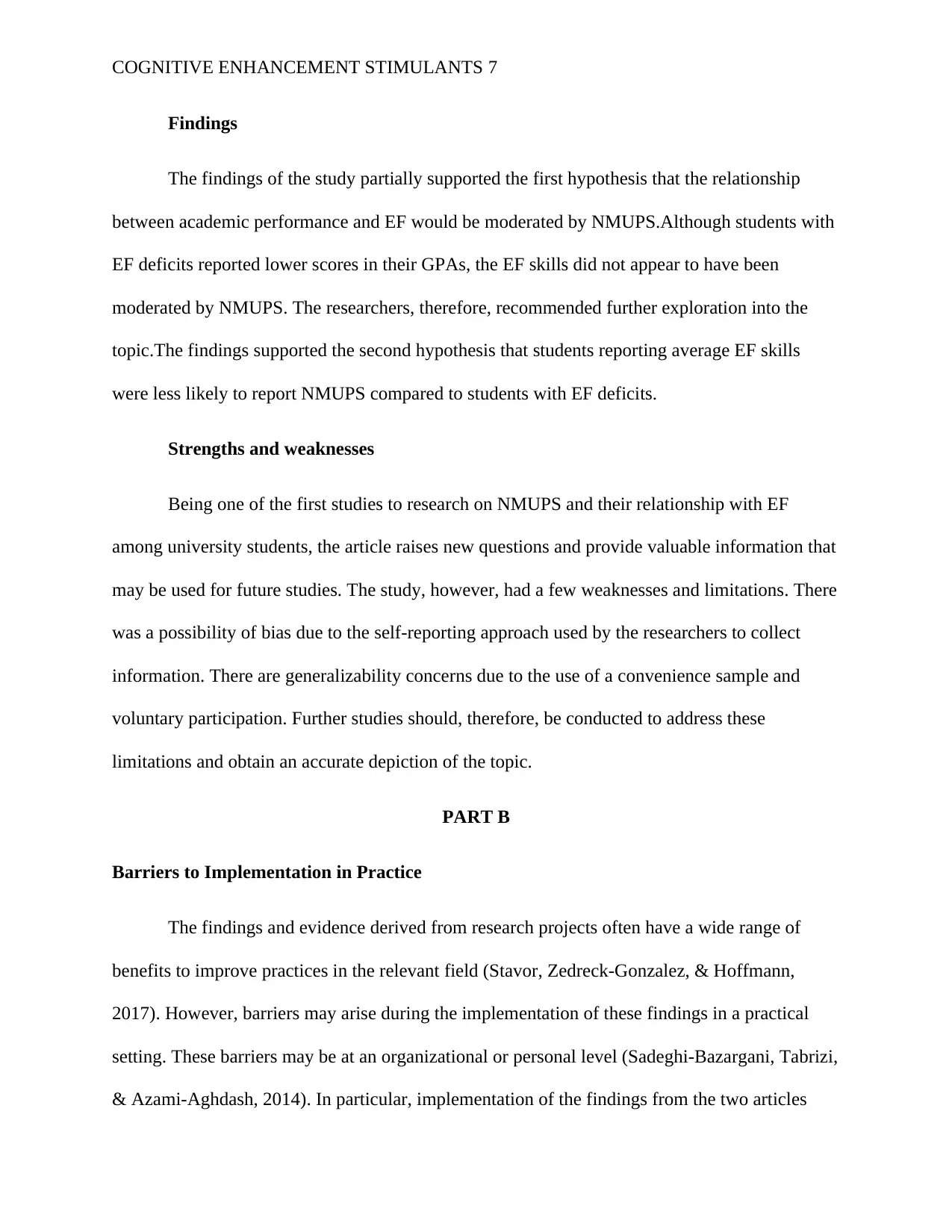
COGNITIVE ENHANCEMENT STIMULANTS 7
Findings
The findings of the study partially supported the first hypothesis that the relationship
between academic performance and EF would be moderated by NMUPS.Although students with
EF deficits reported lower scores in their GPAs, the EF skills did not appear to have been
moderated by NMUPS. The researchers, therefore, recommended further exploration into the
topic.The findings supported the second hypothesis that students reporting average EF skills
were less likely to report NMUPS compared to students with EF deficits.
Strengths and weaknesses
Being one of the first studies to research on NMUPS and their relationship with EF
among university students, the article raises new questions and provide valuable information that
may be used for future studies. The study, however, had a few weaknesses and limitations. There
was a possibility of bias due to the self-reporting approach used by the researchers to collect
information. There are generalizability concerns due to the use of a convenience sample and
voluntary participation. Further studies should, therefore, be conducted to address these
limitations and obtain an accurate depiction of the topic.
PART B
Barriers to Implementation in Practice
The findings and evidence derived from research projects often have a wide range of
benefits to improve practices in the relevant field (Stavor, Zedreck-Gonzalez, & Hoffmann,
2017). However, barriers may arise during the implementation of these findings in a practical
setting. These barriers may be at an organizational or personal level (Sadeghi‐Bazargani, Tabrizi,
& Azami‐Aghdash, 2014). In particular, implementation of the findings from the two articles
Findings
The findings of the study partially supported the first hypothesis that the relationship
between academic performance and EF would be moderated by NMUPS.Although students with
EF deficits reported lower scores in their GPAs, the EF skills did not appear to have been
moderated by NMUPS. The researchers, therefore, recommended further exploration into the
topic.The findings supported the second hypothesis that students reporting average EF skills
were less likely to report NMUPS compared to students with EF deficits.
Strengths and weaknesses
Being one of the first studies to research on NMUPS and their relationship with EF
among university students, the article raises new questions and provide valuable information that
may be used for future studies. The study, however, had a few weaknesses and limitations. There
was a possibility of bias due to the self-reporting approach used by the researchers to collect
information. There are generalizability concerns due to the use of a convenience sample and
voluntary participation. Further studies should, therefore, be conducted to address these
limitations and obtain an accurate depiction of the topic.
PART B
Barriers to Implementation in Practice
The findings and evidence derived from research projects often have a wide range of
benefits to improve practices in the relevant field (Stavor, Zedreck-Gonzalez, & Hoffmann,
2017). However, barriers may arise during the implementation of these findings in a practical
setting. These barriers may be at an organizational or personal level (Sadeghi‐Bazargani, Tabrizi,
& Azami‐Aghdash, 2014). In particular, implementation of the findings from the two articles
Paraphrase This Document
Need a fresh take? Get an instant paraphrase of this document with our AI Paraphraser
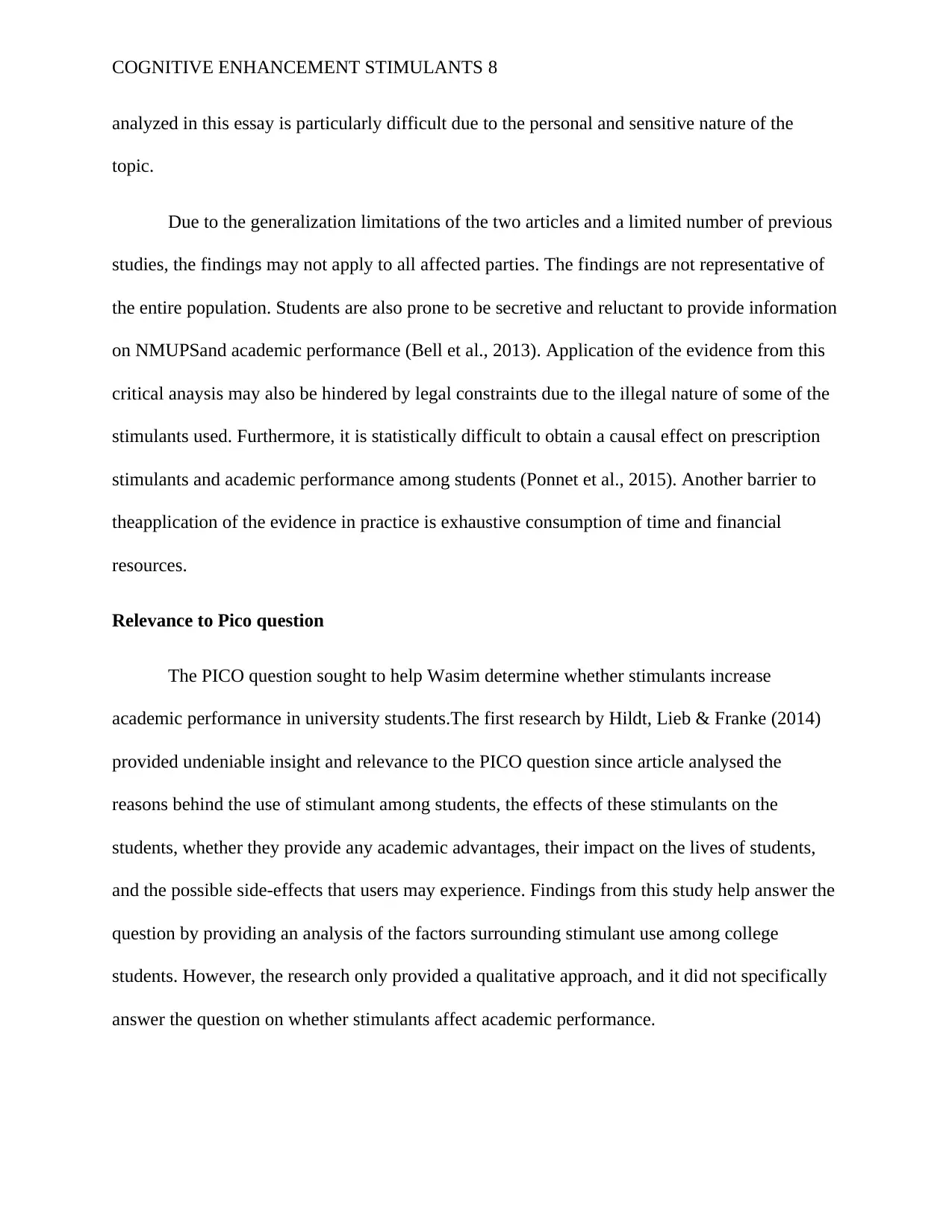
COGNITIVE ENHANCEMENT STIMULANTS 8
analyzed in this essay is particularly difficult due to the personal and sensitive nature of the
topic.
Due to the generalization limitations of the two articles and a limited number of previous
studies, the findings may not apply to all affected parties. The findings are not representative of
the entire population. Students are also prone to be secretive and reluctant to provide information
on NMUPSand academic performance (Bell et al., 2013). Application of the evidence from this
critical anaysis may also be hindered by legal constraints due to the illegal nature of some of the
stimulants used. Furthermore, it is statistically difficult to obtain a causal effect on prescription
stimulants and academic performance among students (Ponnet et al., 2015). Another barrier to
theapplication of the evidence in practice is exhaustive consumption of time and financial
resources.
Relevance to Pico question
The PICO question sought to help Wasim determine whether stimulants increase
academic performance in university students.The first research by Hildt, Lieb & Franke (2014)
provided undeniable insight and relevance to the PICO question since article analysed the
reasons behind the use of stimulant among students, the effects of these stimulants on the
students, whether they provide any academic advantages, their impact on the lives of students,
and the possible side-effects that users may experience. Findings from this study help answer the
question by providing an analysis of the factors surrounding stimulant use among college
students. However, the research only provided a qualitative approach, and it did not specifically
answer the question on whether stimulants affect academic performance.
analyzed in this essay is particularly difficult due to the personal and sensitive nature of the
topic.
Due to the generalization limitations of the two articles and a limited number of previous
studies, the findings may not apply to all affected parties. The findings are not representative of
the entire population. Students are also prone to be secretive and reluctant to provide information
on NMUPSand academic performance (Bell et al., 2013). Application of the evidence from this
critical anaysis may also be hindered by legal constraints due to the illegal nature of some of the
stimulants used. Furthermore, it is statistically difficult to obtain a causal effect on prescription
stimulants and academic performance among students (Ponnet et al., 2015). Another barrier to
theapplication of the evidence in practice is exhaustive consumption of time and financial
resources.
Relevance to Pico question
The PICO question sought to help Wasim determine whether stimulants increase
academic performance in university students.The first research by Hildt, Lieb & Franke (2014)
provided undeniable insight and relevance to the PICO question since article analysed the
reasons behind the use of stimulant among students, the effects of these stimulants on the
students, whether they provide any academic advantages, their impact on the lives of students,
and the possible side-effects that users may experience. Findings from this study help answer the
question by providing an analysis of the factors surrounding stimulant use among college
students. However, the research only provided a qualitative approach, and it did not specifically
answer the question on whether stimulants affect academic performance.
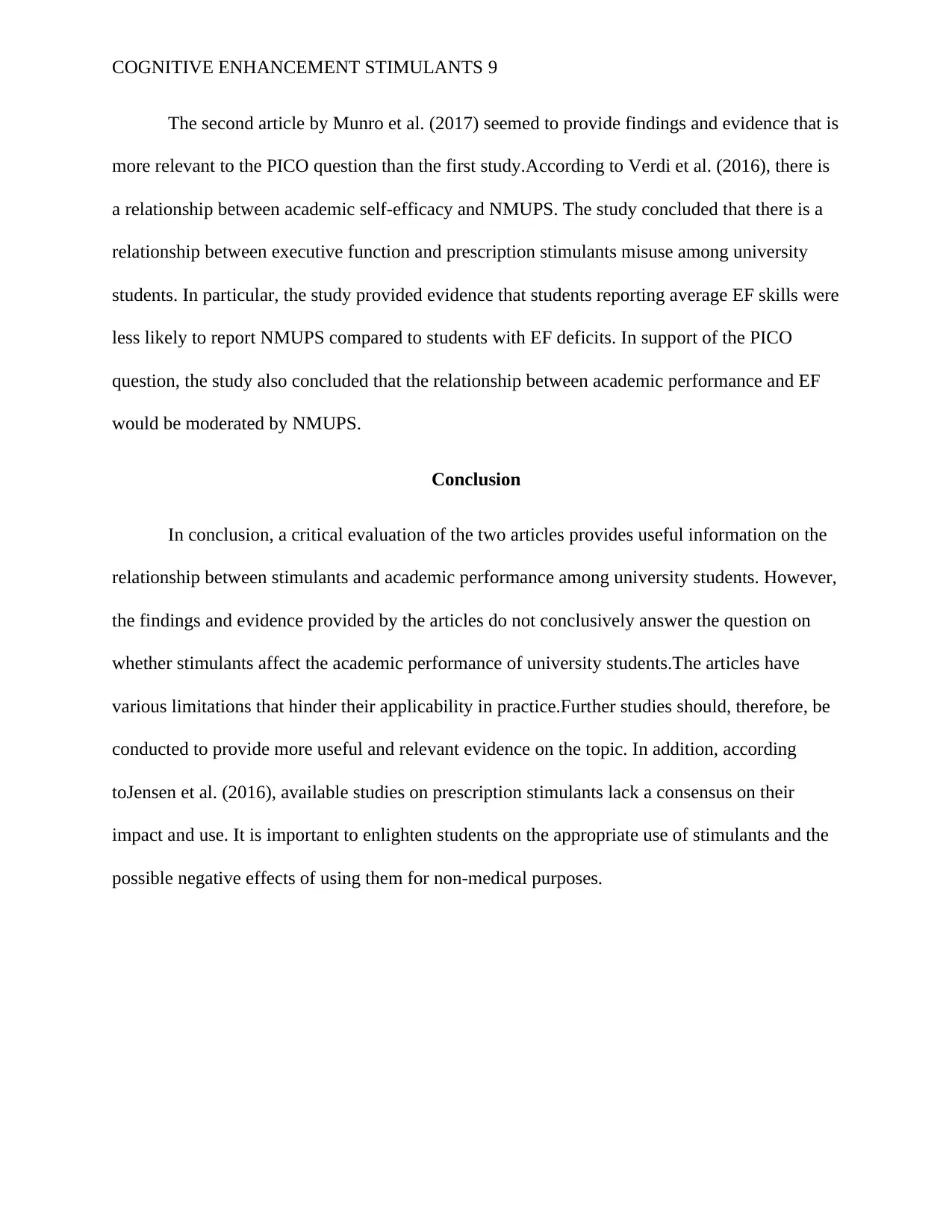
COGNITIVE ENHANCEMENT STIMULANTS 9
The second article by Munro et al. (2017) seemed to provide findings and evidence that is
more relevant to the PICO question than the first study.According to Verdi et al. (2016), there is
a relationship between academic self-efficacy and NMUPS. The study concluded that there is a
relationship between executive function and prescription stimulants misuse among university
students. In particular, the study provided evidence that students reporting average EF skills were
less likely to report NMUPS compared to students with EF deficits. In support of the PICO
question, the study also concluded that the relationship between academic performance and EF
would be moderated by NMUPS.
Conclusion
In conclusion, a critical evaluation of the two articles provides useful information on the
relationship between stimulants and academic performance among university students. However,
the findings and evidence provided by the articles do not conclusively answer the question on
whether stimulants affect the academic performance of university students.The articles have
various limitations that hinder their applicability in practice.Further studies should, therefore, be
conducted to provide more useful and relevant evidence on the topic. In addition, according
toJensen et al. (2016), available studies on prescription stimulants lack a consensus on their
impact and use. It is important to enlighten students on the appropriate use of stimulants and the
possible negative effects of using them for non-medical purposes.
The second article by Munro et al. (2017) seemed to provide findings and evidence that is
more relevant to the PICO question than the first study.According to Verdi et al. (2016), there is
a relationship between academic self-efficacy and NMUPS. The study concluded that there is a
relationship between executive function and prescription stimulants misuse among university
students. In particular, the study provided evidence that students reporting average EF skills were
less likely to report NMUPS compared to students with EF deficits. In support of the PICO
question, the study also concluded that the relationship between academic performance and EF
would be moderated by NMUPS.
Conclusion
In conclusion, a critical evaluation of the two articles provides useful information on the
relationship between stimulants and academic performance among university students. However,
the findings and evidence provided by the articles do not conclusively answer the question on
whether stimulants affect the academic performance of university students.The articles have
various limitations that hinder their applicability in practice.Further studies should, therefore, be
conducted to provide more useful and relevant evidence on the topic. In addition, according
toJensen et al. (2016), available studies on prescription stimulants lack a consensus on their
impact and use. It is important to enlighten students on the appropriate use of stimulants and the
possible negative effects of using them for non-medical purposes.
⊘ This is a preview!⊘
Do you want full access?
Subscribe today to unlock all pages.

Trusted by 1+ million students worldwide
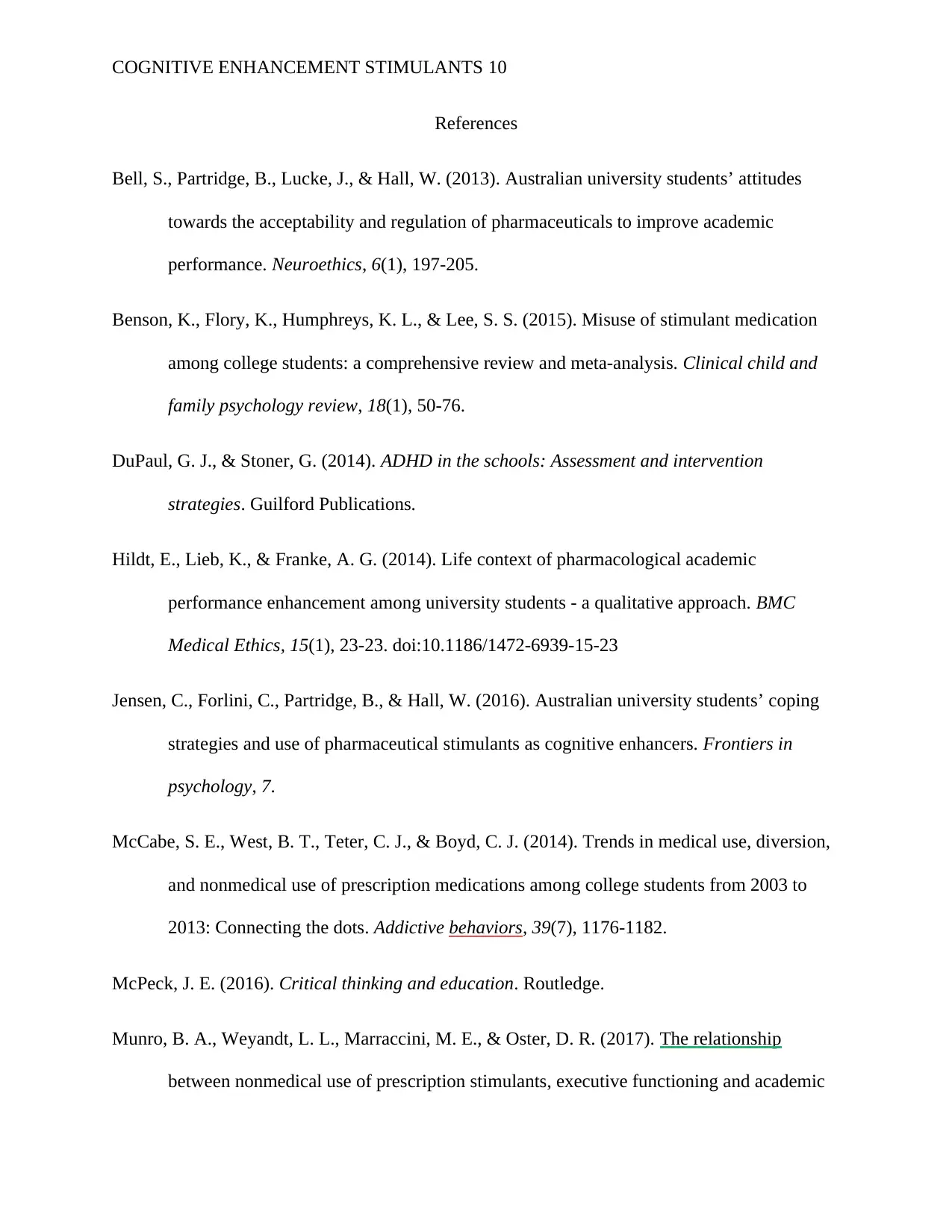
COGNITIVE ENHANCEMENT STIMULANTS 10
References
Bell, S., Partridge, B., Lucke, J., & Hall, W. (2013). Australian university students’ attitudes
towards the acceptability and regulation of pharmaceuticals to improve academic
performance. Neuroethics, 6(1), 197-205.
Benson, K., Flory, K., Humphreys, K. L., & Lee, S. S. (2015). Misuse of stimulant medication
among college students: a comprehensive review and meta-analysis. Clinical child and
family psychology review, 18(1), 50-76.
DuPaul, G. J., & Stoner, G. (2014). ADHD in the schools: Assessment and intervention
strategies. Guilford Publications.
Hildt, E., Lieb, K., & Franke, A. G. (2014). Life context of pharmacological academic
performance enhancement among university students - a qualitative approach. BMC
Medical Ethics, 15(1), 23-23. doi:10.1186/1472-6939-15-23
Jensen, C., Forlini, C., Partridge, B., & Hall, W. (2016). Australian university students’ coping
strategies and use of pharmaceutical stimulants as cognitive enhancers. Frontiers in
psychology, 7.
McCabe, S. E., West, B. T., Teter, C. J., & Boyd, C. J. (2014). Trends in medical use, diversion,
and nonmedical use of prescription medications among college students from 2003 to
2013: Connecting the dots. Addictive behaviors, 39(7), 1176-1182.
McPeck, J. E. (2016). Critical thinking and education. Routledge.
Munro, B. A., Weyandt, L. L., Marraccini, M. E., & Oster, D. R. (2017). The relationship
between nonmedical use of prescription stimulants, executive functioning and academic
References
Bell, S., Partridge, B., Lucke, J., & Hall, W. (2013). Australian university students’ attitudes
towards the acceptability and regulation of pharmaceuticals to improve academic
performance. Neuroethics, 6(1), 197-205.
Benson, K., Flory, K., Humphreys, K. L., & Lee, S. S. (2015). Misuse of stimulant medication
among college students: a comprehensive review and meta-analysis. Clinical child and
family psychology review, 18(1), 50-76.
DuPaul, G. J., & Stoner, G. (2014). ADHD in the schools: Assessment and intervention
strategies. Guilford Publications.
Hildt, E., Lieb, K., & Franke, A. G. (2014). Life context of pharmacological academic
performance enhancement among university students - a qualitative approach. BMC
Medical Ethics, 15(1), 23-23. doi:10.1186/1472-6939-15-23
Jensen, C., Forlini, C., Partridge, B., & Hall, W. (2016). Australian university students’ coping
strategies and use of pharmaceutical stimulants as cognitive enhancers. Frontiers in
psychology, 7.
McCabe, S. E., West, B. T., Teter, C. J., & Boyd, C. J. (2014). Trends in medical use, diversion,
and nonmedical use of prescription medications among college students from 2003 to
2013: Connecting the dots. Addictive behaviors, 39(7), 1176-1182.
McPeck, J. E. (2016). Critical thinking and education. Routledge.
Munro, B. A., Weyandt, L. L., Marraccini, M. E., & Oster, D. R. (2017). The relationship
between nonmedical use of prescription stimulants, executive functioning and academic
Paraphrase This Document
Need a fresh take? Get an instant paraphrase of this document with our AI Paraphraser

COGNITIVE ENHANCEMENT STIMULANTS 11
outcomes. Addictive Behaviors, 65, 250-257.
doi:http://dx.doi.org/10.1016/j.addbeh.2016.08.023
Sadeghi‐Bazargani, H., Tabrizi, J. S., & Azami‐Aghdash, S. (2014). Barriers to evidence‐based
medicine: a systematic review. Journal of evaluation in clinical practice, 20(6), 793-802.
Stavor, D. C., Zedreck-Gonzalez, J., & Hoffmann, R. L. (2017). Improving the use of evidence-
based practice and research utilization through the identification of barriers to
implementation in a critical access hospital. Journal of Nursing Administration, 47(1),
56-61.
Ponnet, K., Wouters, E., Walrave, M., Heirman, W., & Van Hal, G. (2015). Predicting students’
intention to use stimulants for academic performance enhancement. Substance use &
misuse, 50(3), 275-282.
Verdi, G., Weyandt, L. L., & Zavras, B. M. (2016). Non-medical prescription stimulant use in
graduate students: relationship with academic self-efficacy and psychological
variables. Journal of attention disorders, 20(9), 741-753.
Vrecko, S. (2015). Everyday drug diversions: A qualitative study of the illicit exchange and non-
medical use of prescription stimulants on a university campus. Social Science &
Medicine, 131, 297-304.
outcomes. Addictive Behaviors, 65, 250-257.
doi:http://dx.doi.org/10.1016/j.addbeh.2016.08.023
Sadeghi‐Bazargani, H., Tabrizi, J. S., & Azami‐Aghdash, S. (2014). Barriers to evidence‐based
medicine: a systematic review. Journal of evaluation in clinical practice, 20(6), 793-802.
Stavor, D. C., Zedreck-Gonzalez, J., & Hoffmann, R. L. (2017). Improving the use of evidence-
based practice and research utilization through the identification of barriers to
implementation in a critical access hospital. Journal of Nursing Administration, 47(1),
56-61.
Ponnet, K., Wouters, E., Walrave, M., Heirman, W., & Van Hal, G. (2015). Predicting students’
intention to use stimulants for academic performance enhancement. Substance use &
misuse, 50(3), 275-282.
Verdi, G., Weyandt, L. L., & Zavras, B. M. (2016). Non-medical prescription stimulant use in
graduate students: relationship with academic self-efficacy and psychological
variables. Journal of attention disorders, 20(9), 741-753.
Vrecko, S. (2015). Everyday drug diversions: A qualitative study of the illicit exchange and non-
medical use of prescription stimulants on a university campus. Social Science &
Medicine, 131, 297-304.
1 out of 11
Related Documents
Your All-in-One AI-Powered Toolkit for Academic Success.
+13062052269
info@desklib.com
Available 24*7 on WhatsApp / Email
![[object Object]](/_next/static/media/star-bottom.7253800d.svg)
Unlock your academic potential
© 2024 | Zucol Services PVT LTD | All rights reserved.





